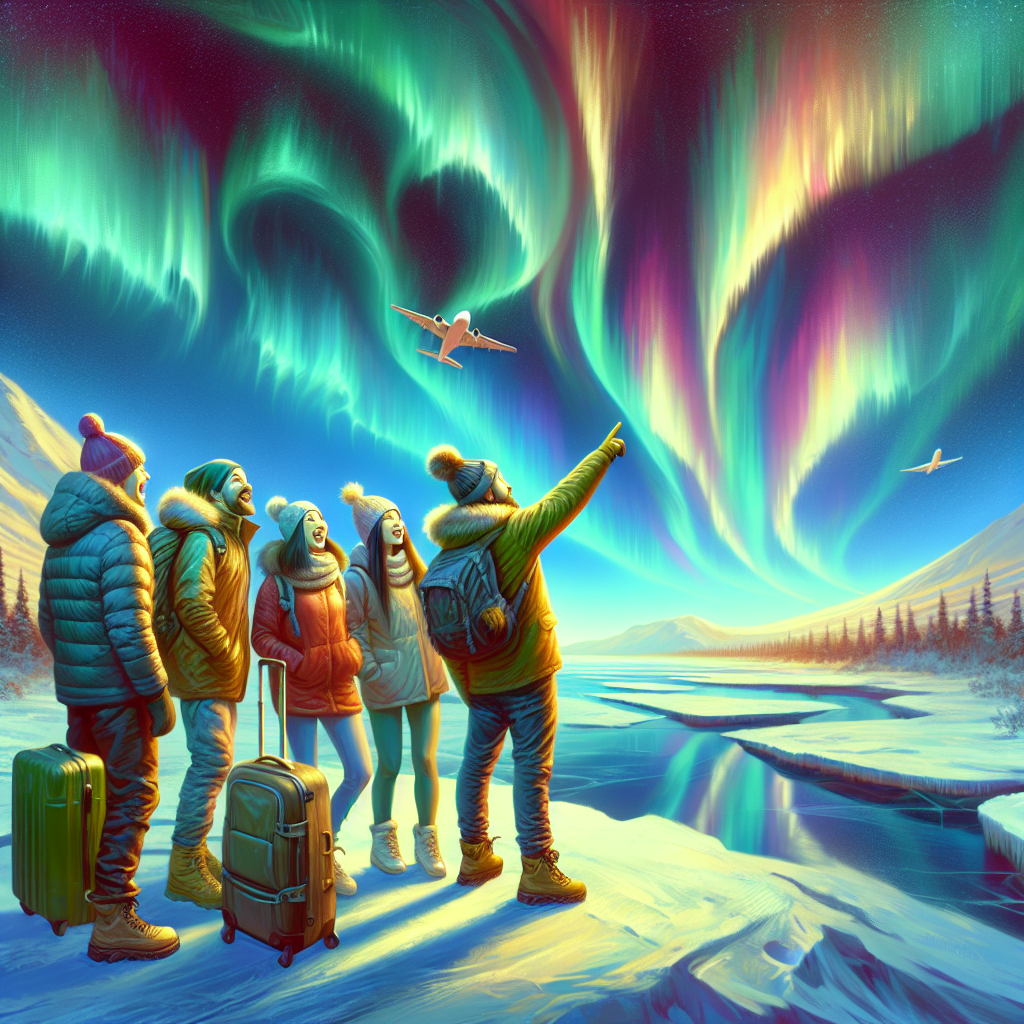Yamadura Mini Refillable Perfume Portable Atomizer Bottle Refillable Perfume Spray, Refill Pump Case for Traveling and Outgoing (5ml, 4 Pack) 4
$8.99 (as of April 16, 2025 04:30 GMT +00:00 - More info)-
Table of Contents
“Chase the dancing skies: Plan your ultimate Northern Lights adventure!”
Introduction
Planning a trip to see the Northern Lights can be an exciting and memorable experience. The Northern Lights, also known as the Aurora Borealis, are a natural phenomenon that occurs in the polar regions. This breathtaking display of colorful lights dancing across the night sky is a sight to behold. To ensure a successful trip, it is important to consider factors such as the best time to visit, suitable locations, and necessary preparations. By carefully planning your trip, you can increase your chances of witnessing this awe-inspiring spectacle firsthand.
Top Destinations for Viewing the Northern Lights
The Northern Lights, also known as the Aurora Borealis, are a breathtaking natural phenomenon that can only be witnessed in certain parts of the world. If you’re planning a trip to see this awe-inspiring display of lights, it’s important to choose the right destination. In this article, we will explore some of the top destinations for viewing the Northern Lights.
One of the most popular destinations for seeing the Northern Lights is Iceland. With its vast, unspoiled landscapes and minimal light pollution, Iceland offers the perfect conditions for witnessing this natural wonder. The best time to visit Iceland for the Northern Lights is during the winter months, from September to April. Some of the best spots for viewing the lights in Iceland include Reykjavik, the capital city, and the Golden Circle, a popular tourist route that takes you to some of the country’s most stunning natural attractions.
Another top destination for viewing the Northern Lights is Norway. The country’s northernmost regions, such as Tromsø and the Lofoten Islands, are known for their clear skies and frequent sightings of the Aurora Borealis. Norway also offers a range of activities to enhance your Northern Lights experience, such as dog sledding and snowmobiling. To increase your chances of seeing the lights, it’s recommended to visit Norway between October and March, when the nights are longer and darker.
If you’re looking for a more remote and off-the-beaten-path destination, consider visiting Finland. The Finnish Lapland, located in the Arctic Circle, is a prime location for viewing the Northern Lights. The region is known for its pristine wilderness and unique experiences, such as staying in glass igloos or going on reindeer safaris. The best time to visit Finland for the Northern Lights is from September to March, with December being particularly popular due to the Christmas festivities and the chance to see the lights dancing above Santa Claus Village.
Canada is also a top destination for witnessing the Northern Lights. The country’s northern regions, including Yukon, Northwest Territories, and Nunavut, offer excellent opportunities for viewing the Aurora Borealis. In addition to the lights, Canada’s vast wilderness provides a stunning backdrop for your Northern Lights adventure. The best time to visit Canada for the Northern Lights is from late August to early April, with peak viewing season occurring in the winter months.
Lastly, Sweden is another fantastic destination for experiencing the Northern Lights. The country’s northernmost regions, such as Abisko and Kiruna, are renowned for their clear skies and frequent displays of the Aurora Borealis. Sweden also offers unique activities like ice hotels and snowshoeing, allowing you to make the most of your Northern Lights trip. The best time to visit Sweden for the lights is from September to March, with December and January being particularly popular due to the long nights.
In conclusion, if you’re planning a trip to see the Northern Lights, there are several top destinations to consider. Whether you choose Iceland, Norway, Finland, Canada, or Sweden, each offers its own unique experiences and opportunities for witnessing this mesmerizing natural phenomenon. Remember to plan your trip during the optimal viewing season and be prepared for the cold weather. With a bit of luck and the right destination, you’ll have the chance to witness the Northern Lights in all their glory.
Best Time to Visit the Northern Lights

The Northern Lights, also known as the Aurora Borealis, are a breathtaking natural phenomenon that can be seen in certain parts of the world. Planning a trip to see the Northern Lights can be an exciting and memorable experience. However, it is important to choose the best time to visit in order to maximize your chances of witnessing this awe-inspiring display of lights.
The best time to see the Northern Lights is during the winter months, from September to March. This is because the nights are longer and darker, providing optimal conditions for viewing the lights. Additionally, the cold weather helps to reduce light pollution, making the lights even more visible.
Within this winter period, there are certain months that are considered to be the prime time for viewing the Northern Lights. These months include October, November, February, and March. During these months, the geomagnetic activity is typically higher, increasing the chances of seeing the lights. It is important to note that the Northern Lights are a natural phenomenon and can be unpredictable, so there is no guarantee of seeing them even during the best time to visit.
When planning your trip, it is also important to consider the location. The Northern Lights can be seen in several countries, including Norway, Sweden, Finland, Iceland, Canada, and Alaska. Each location offers a unique experience, so it is worth researching and choosing the one that best suits your preferences.
In Norway, for example, the city of Tromsø is a popular destination for Northern Lights enthusiasts. It is located within the Arctic Circle, which means that it has a high probability of seeing the lights. Tromsø also offers a range of activities and accommodations, making it a convenient and enjoyable place to base your trip.
In Iceland, the town of Reykjavik is another great option for viewing the Northern Lights. It is known for its stunning landscapes and natural beauty, providing a picturesque backdrop for the lights. Reykjavik also offers various tours and excursions that allow you to explore the surrounding areas and increase your chances of seeing the lights.
When planning your trip, it is important to check the weather conditions and the forecast for the specific location you are visiting. Cloudy or overcast skies can obstruct the view of the Northern Lights, so it is best to choose a time when the weather is clear. Additionally, it is advisable to stay in a location away from city lights, as light pollution can diminish the visibility of the lights.
In conclusion, the best time to visit the Northern Lights is during the winter months, from September to March. Within this period, the months of October, November, February, and March are considered to be the prime time for viewing the lights. It is important to choose a location that offers optimal conditions and activities for your trip. Remember to check the weather conditions and plan accordingly to maximize your chances of witnessing this incredible natural phenomenon.
Essential Tips for Planning a Northern Lights Trip
Planning a trip to see the Northern Lights can be an exciting and unforgettable experience. The ethereal beauty of the Aurora Borealis is a natural wonder that captivates people from all over the world. However, to ensure a successful and enjoyable trip, it is important to plan ahead and consider a few essential tips.
First and foremost, it is crucial to choose the right time and location for your Northern Lights adventure. The best time to see the lights is during the winter months when the nights are long and dark. Popular destinations for viewing the Northern Lights include Norway, Iceland, Finland, and Alaska. Researching the optimal time and location will increase your chances of witnessing this breathtaking phenomenon.
Once you have decided on a destination, it is important to book your accommodations well in advance. Northern Lights hotspots tend to attract a large number of tourists, especially during peak viewing seasons. By securing your lodging early, you can avoid disappointment and ensure a comfortable stay. Additionally, consider staying in a remote location away from light pollution to enhance your chances of seeing the lights.
Another crucial aspect of planning a Northern Lights trip is understanding the weather conditions. The lights are most visible on clear, cloudless nights, so it is essential to monitor the weather forecast before your trip. Be prepared for cold temperatures and pack appropriate clothing, including thermal layers, hats, gloves, and warm boots. It is also advisable to bring a good quality camera to capture the beauty of the lights.
To maximize your chances of seeing the Northern Lights, consider booking a guided tour. Experienced guides are knowledgeable about the best viewing spots and can provide valuable insights about the lights. They can also offer tips on photography techniques to capture the lights in all their glory. Additionally, joining a tour allows you to meet like-minded travelers and share the experience with others.
While the main focus of your trip may be the Northern Lights, it is important to also explore the surrounding attractions and activities. Many Northern Lights destinations offer a range of winter activities such as dog sledding, snowmobiling, and ice fishing. These activities not only add to the overall experience but also provide alternative options in case the lights are not visible due to weather conditions.
Lastly, it is essential to manage your expectations when planning a Northern Lights trip. While the lights are a natural phenomenon, they are not guaranteed to appear every night. Patience and flexibility are key, as the lights can be elusive and unpredictable. Remember to enjoy the journey and embrace the beauty of the destination, even if you do not witness the lights on every night of your trip.
In conclusion, planning a trip to see the Northern Lights requires careful consideration and preparation. Choosing the right time and location, booking accommodations in advance, understanding the weather conditions, joining a guided tour, exploring other activities, and managing expectations are all essential tips for a successful Northern Lights adventure. By following these tips, you can increase your chances of witnessing this awe-inspiring natural wonder and create memories that will last a lifetime.
Conclusion
In conclusion, planning a trip to see the Northern Lights requires careful consideration of factors such as the ideal location, timing, weather conditions, and accommodation options. Researching and selecting a destination known for its clear skies and high chances of aurora borealis sightings is crucial. Additionally, planning the trip during the winter months when the nights are longer and darker increases the likelihood of witnessing this natural phenomenon. It is also important to be prepared for cold weather and pack appropriate clothing and equipment. Overall, with proper planning and preparation, a trip to see the Northern Lights can be a truly magical and unforgettable experience.







